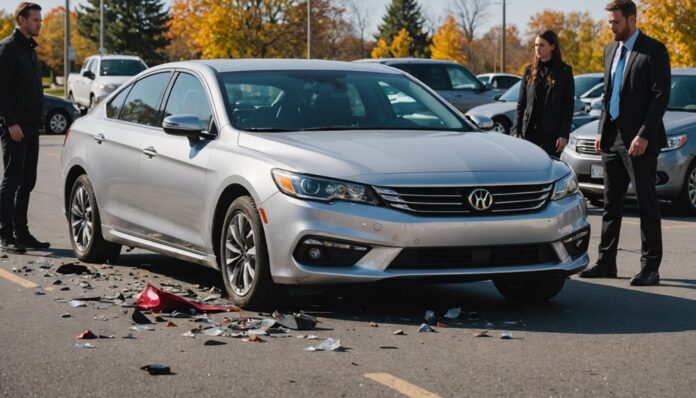Following a minor car accident, drivers should prioritize moving their vehicles to a safe location to prevent further incidents. Once secured, evaluating injuries and damage to all parties involved is imperative. This initial evaluation sets the stage for the subsequent steps, including exchanging essential information and reporting the incident to authorities. A thorough understanding of these procedures is important to maneuver through the aftermath of a minor car accident effectively.
Highlights
- Move vehicles to a safe location to prevent further accidents and ensure safety for all parties involved.
- Check for injuries and damage, documenting visible injuries and inspecting vehicles and surrounding property.
- Exchange contact and insurance information with the other party, including names, phone numbers, and policy numbers.
- Document the scene and damage with clear photos, taking note of witness statements and contact information.
- Report the incident to the authorities, filing a police report regardless of accident severity and providing detailed information.
Move to a Safe Location
Following a minor car accident, the involved parties should prioritize moving their vehicles to a safe location. This is vital to prevent further accidents and guarantee the safety of all parties involved.
Safe driving practices dictate that vehicles should be moved to the side of the road or a nearby parking lot, away from traffic. This helps to prevent another accident from occurring and allows for a smoother exchange of information.
Accident prevention is key, and moving to a safe location is an important step in the process. By doing so, parties can avoid further risks and focus on exchanging information and resolving the issue at hand.
This responsible behavior promotes a sense of community and shared concern for safety.
Check for Injuries and Damage
Once the vehicles are in a safe location, parties should assess the situation to determine if anyone has been injured and evaluate the extent of the damage to the vehicles and surrounding property.
This step is essential in determining the severity of the accident and the necessary course of action. The injury assessment should include checking for visible injuries, asking if anyone is experiencing pain or discomfort, and providing assistance if needed.
The damage evaluation involves inspecting the vehicles for damage, taking note of any visible damage to surrounding property, and documenting the scene if possible. This information will be useful when reporting the incident and seeking any necessary repairs or medical attention.
A thorough assessment guarantees that all parties receive the necessary support.
Exchange Information With the Other Party
A crucial step in handling a minor car accident is the exchange of information with the other party involved. This step helps establish communication and facilitates the resolution process.
Both parties should provide their contact information, including names, phone numbers, and addresses. Additionally, insurance details should be exchanged, including policy numbers and insurance provider information. This guarantees that both parties can reach out to each other and their respective insurers to report the incident.
If there are witnesses present, it is a good idea to collect their statements and contact information as well. This helps build a thorough account of the incident, which can be useful for insurance purposes and any potential disputes that may arise.
Document the Scene and Damage
Photographic evidence is priceless when dealing with the aftermath of a minor car accident. Taking clear photos of the scene and damage can help establish fault and support an insurance claim. This includes documenting vehicle damage, road conditions, and any pertinent traffic signs or signals.
Photos of debris, skid marks, and other aftermath can also be significant. Witness statements can provide additional background and corroborate the sequence of events. Taking note of witness contact information and their account of the accident can also be helpful.
Documenting the scene thoroughly can guarantee that essential details are not forgotten or overlooked, helping to expedite the claims process and reaching a fair resolution.
Report the Incident to the Authorities
Following the thorough documentation of the scene and damage, the next step is to notify the authorities about the incident.
It is crucial to file a report with the police, even if the accident is minor. Police involvement provides an official record of the incident, which can be useful in case of future disputes or insurance claims.
When reporting the incident, provide as much detail as possible, including the location, time, and description of the vehicles involved. The police will likely ask for the documentation and evidence collected at the scene.
Filing a report also helps to guarantee that all parties involved are held accountable for their actions. By involving the authorities, individuals can guarantee a smooth and fair process.
Conclusion
Following a minor car accident, taking the correct steps is vital to guarantee safety, proper documentation, and accountability. Moving to a safe location, checking for injuries and damage, exchanging information, documenting the scene, and reporting the incident to the authorities are all fundamental actions. By completing these steps, individuals can protect themselves and others involved, while also facilitating a smooth and efficient process for resolving any resulting issues.


